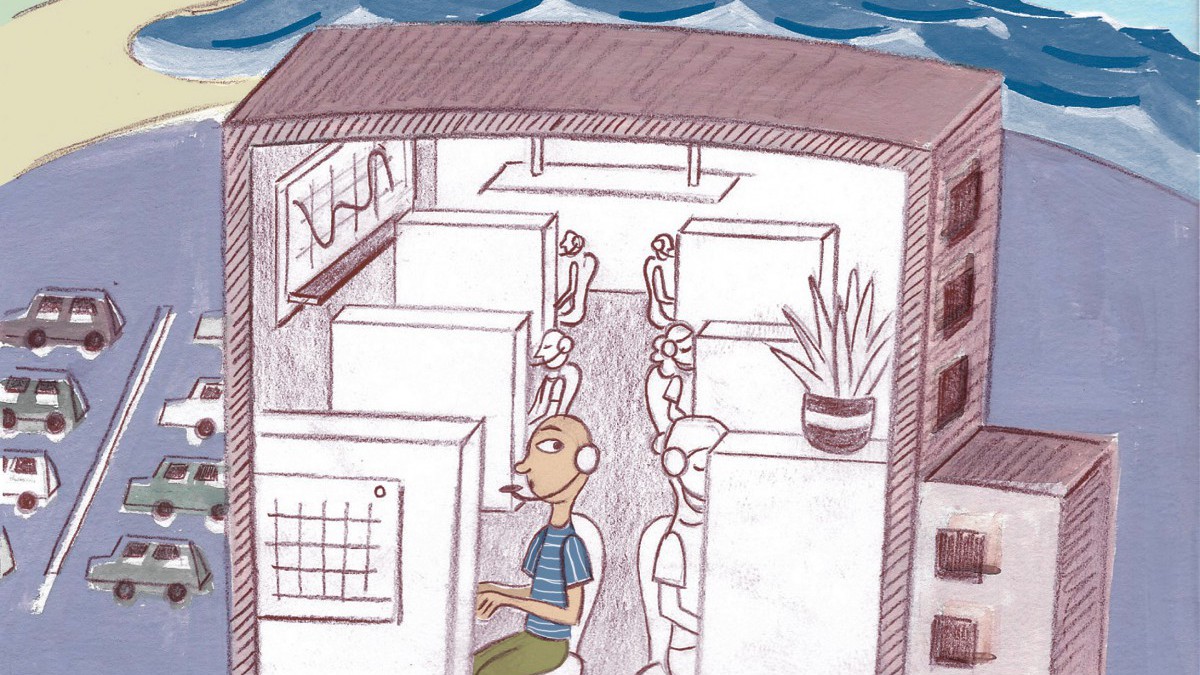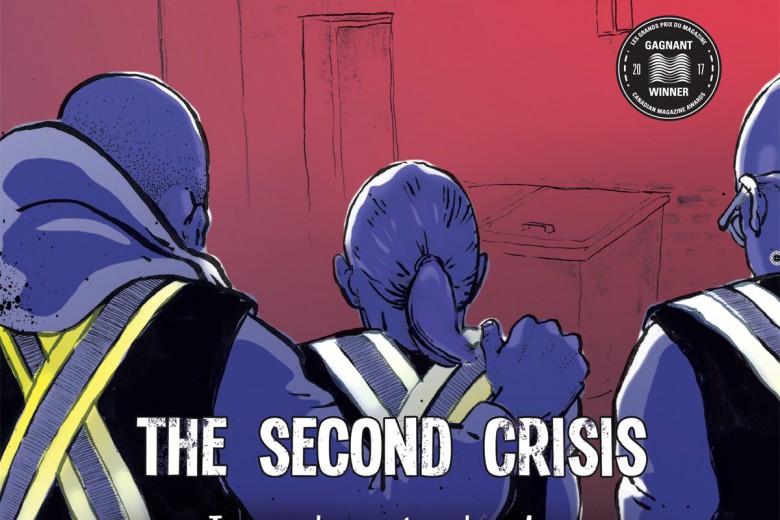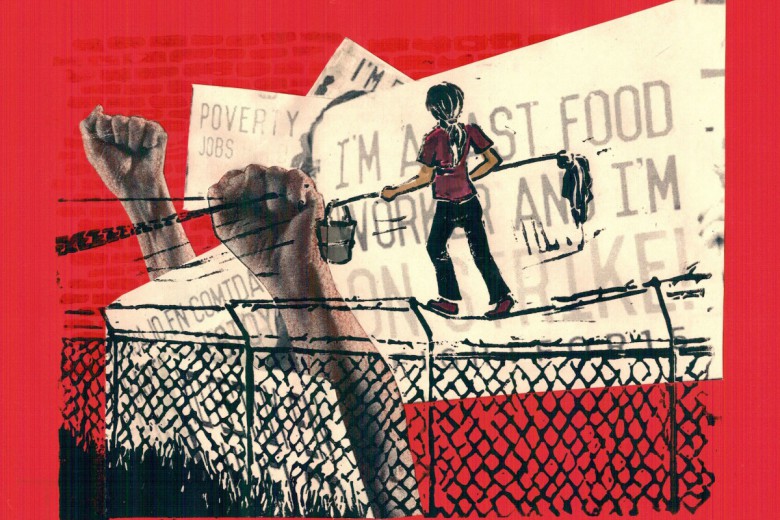What you’re about to read may thwart unionization at my former workplace. St. John’s, N.L. is a small town.
From April until the end of August, I worked at an outbound call centre with low morale and poor working conditions among its staff of minimum-wage interviewers. It wasn’t the worst job in the world, but it typifies the new reality of low-wage, casual, part-time, benefit-poor employment.
In my few months there, barbecues and ice-cream socials with the company owners seemed designed to make up for the low pay. There were no group benefits but there were almost always free bananas. Top performers on a shift were sometimes rewarded with a $5 Tim Hortons gift card. These were the minor palliatives for irregular hours and an increasingly rigid system of rules governing the smallest points of workplace behaviour: in August, alongside a benign reminder to keep our booths clean, interviewers were told not to have cellphones on their person during shifts.
Working there shook my confidence in opinion polling much more than my graduate seminar on political behaviour did. Trust me: workers who poll the popularity of our premiers are too busy holding in their pee to worry about the quality of the data; at the call centre, any time not spent calling or waiting on a call had to be recorded as “idle.” Too many bathroom trips could get you a talking-to by your supervisor.
Workers across Canada face obstacles toward unionization that are no less harsh. An organizer warned me personally about opening the door to risks when I explored forming a union at my own workplace.
“You’ve got to be careful with this, Cory,” the organizer told me over the phone a few weeks ago. “Sometimes your ‘friend’ is not your friend, know what I’m saying?”
With supervisors monitoring interviewers’ words through telephone headsets almost around the clock, nurturing the trust to discuss unionization is difficult, as the risk of being caught is near inescapable.
I hope I have not hindered the prospect of unionization at my former workplace by mentioning it in this article.
But given that such barriers to unionization are typical, it’s no surprise that it takes great energy and creativity to mobilize precarious and young workers, who may have had no opportunity through school, family, or the media to learn about what unions do or stand for. Young workers, facing the risk of unemployment, are increasingly just as likely to cross a picket line as to be on one. For instance, many of the replacement workers (or strikebreakers) at the Chronicle Herald in Halifax are disproportionately at risk of unemployment and many may be strangers to labour activism. Labour unions have to work hard to engage an audience for whom the labour movement is completely obscure. They also have to demonstrate interest in issues the non-unionized youth workforce cares about, like the minimum wage. Sound research on public attitudes toward unionization is “virtually non-existent” – but it’s clear from Atlantic Canadian labour’s experience with replacement workers and campaigns to raise the minimum wage that much work needs to be done. In Newfoundland, labour, student, and community groups were eventually brought together, albeit by a shared and direct threat.
Indeed, worsening workplace conditions caused by the austerity budget in Newfoundland and Labrador have presented immense challenges. But the experience has also offered new opportunities for coalition-building around a common future – even if it’s a future of unprecedented risk.
“Our movement is aging just like the rest of the population. It’s really important that we engage young workers,” Mary Shortall, president of the Newfoundland and Labrador Federation of Labour, told me, citing conferences, social media, administrative changes, research, mentoring, and successorship programs as some of the movement’s current strategies for outreach.
“The union movement has to get its act together. We don’t always make our movement feel like it’s a movement young workers can identify with – we have to do things differently. We have to allow them to feel that the union belongs to them as well.”
That may prove difficult, however, given the barriers in place for many workers in Atlantic Canada.
In 2014, the Progressive Conservative government in Newfoundland and Labrador capitulated to employers and rolled back labour legislation introduced two years prior, eliminating automatic card check certification and introducing a secret ballot requirement – essentially erecting a barrier to organizing a union. The changes went through, to no one’s surprise, without much public notice.
But perhaps throughout Atlantic Canada, the ease with which this change occurred is reflective of the state of the labour movement: constantly at risk of being seen as divisive or self-interested. It’s a strange state of affairs. Atlantic Canada, and Newfoundland in particular, has some of the lowest health and social welfare outcomes, including the highest rate of child poverty of all Canadian cities, but this has never translated into strong support for workers’ rights. In electoral politics, the NDP – ostensibly the party most likely to bolster and defend labour rights – served only a single term (and an unpopular, business-friendly one at that) in government in Nova Scotia, and it has no seats in the provincial legislatures of Prince Edward Island or New Brunswick.
Unlike Quebec and B.C., Atlantic Canada has no strikebreaking legislation that would prevent employers from hiring replacement workers when employees strike. An absence of pro-worker laws results in prolonged labour disputes, such as Newfoundland’s Labatt brewery strike. The strike by the Halifax Typographical Union (HTU) at the Chronicle Herald, Halifax’s daily newspaper, has dragged on since late January, largely because the newspaper has hired replacement workers.
Nova Scotia and Prince Edward Island have the dubious privilege of having the highest threshold at which employees must be paid overtime, at a ghastly 48 hours per week (the laws in these provinces have extensive exceptions to the general overtime rule for farm workers, live-in health-care providers, trades apprentices, and other workers). New Brunswick is tied with Alberta and Ontario for the second-highest threshold, at 44 hours.
Nova Scotia’s labour laws have been cited as among the most regressive in the country, tracing back to 1979’s “Michelin Bill,” when the corporate-compliant Progressive Conservative government amended the Trade Union Act to make it difficult for workers to unionize multi-factory employees. This legacy continues, with the reigning Liberal government waging what the Canadian Centre for Policy Alternatives (CCPA) called last year a “breathtaking barrage on labour” since taking power in 2013.
For nearly 12 years beginning in 2002, Newfoundland and Labrador’s provincial government convened a tripartite council between its executive, labour groups, and business representatives. It was founded, Memorial University professor of political science Chris Dunn explains, after a review of similar models in Ireland, Iceland, and the Netherlands. It was not to last, however. Shortall, writing in Rankandfile.ca, said that the council came to an end when employers withdrew, “preferring instead bilateral dialogue with government.”
Perhaps most troubling is an apparent attempt by Atlantic Canadian provincial governments to lower labour standards under the guise of harmonization.
“When the Atlantic Federation of Labour presidents meet, it’s very interesting because they’re all [under] Liberal governments. But what we’re seeing government-wise is a concerted effort on behalf of government to work together – but not to the benefit of workers and young people. What’s been happening in the Atlantic region, as far as we can see, is that they’re starting to look at pieces of legislation like employment standards, labour relations, and occupational health and safety. They’re talking about ‘harmonizing’: that’s not about making it the best piece of legislation, that’s about taking the worst pieces and creating legislation that’s worst for workers,” says Shortall.
Shortall noted that Newfoundland’s government is less fixated on the idea than the other Atlantic provinces because it is singularly focused on reducing the deficit. “Their hesitation is probably just a hesitation on everything.”
Fight for $15 and a union
One of the salient battles in Atlantic Canada right now is the fight for fair wages and unionization in Nova Scotia. In August, I spoke with Jonethan Brigley, chair of the Dartmouth branch of Nova Scotia ACORN (Association of Community Organizations for Reform Now), affiliate of ACORN Canada. He told me that many workers and members of the public simply accept the status quo – a significant barrier that shows how much more education and outreach work must be done.
Founded in Cape Breton in 2011, Nova Scotia ACORN has organized around gentrification, landlord licensing, predatory lending, and wages in Nova Scotia. Its members are part of the Fair Wage Coalition, which also includes Solidarity Halifax, the Nova Scotia Federation of Labour, Nova Scotia’s Canadian Federation of Students’ branch, and other labour and student groups.
Brigley works full-time at an A&W restaurant kitchen.
He had organized a rally in April near a Dartmouth McDonald’s, which sought to bring greater awareness to the need for a higher minimum wage.
“We had a lot of people who did stop and took flyers. But a lot of people were just [making] a judgment of how we were going to sustain a $15-an-hour minimum wage.” The public response seemed evenly divided.
“They don’t see why they should be paying those with part-time jobs, such as those in fast-food restaurants, more,” Brigley says.
Motivating workers to show up to such rallies, whatever their cause, can also be difficult.
“It’s easy to get students out there,” Brigley says, but turning out full-time workers was harder. “A lot of workers are hesitant. If they’re caught protesting, depending on their job, the [workplace] may frown upon them.” In the case of Just Us! Coffee Roasters Co-op in Nova Scotia, workers lost their jobs after attempting to unionize.
Countless workers, Brigley says, including many at his A&W location, buy into the idea that employers cannot sustain a $15-an-hour minimum wage, a myth propagated by the government itself.
“The current [provincial] government won’t push for that because … well, it gives many reasons: that it will crush small businesses, people will lose jobs – without having the statistics to back it up,” he continued. John Schmitt, economist at the Washington-based Center for Economic and Policy Research, conducted large, systematic meta-analysis of the effects of minimum wage increases and concluded that they have “little or no discernible effect” on employment prospects. Employers, Schmitt says, actually appear to adjust just fine, because higher wages reduce turnover.
But just as workers face obstacles like intimidation to organizing, unionized workers themselves are under severe pressure. The ongoing strike at the Chronicle Herald has tested the stamina of workers young and old for months – and, although morale rises and falls, the dispute shows no signs of being resolved soon.
Since late January 2016, the newsroom staff has been on strike after the newspaper moved to reduce wages and staffing, and eliminate gender parity policies in hiring.
The Chronicle Herald has faced intense scrutiny since the strike began, with the HTU drawing attention to the shoddy journalism by replacement workers who had moved in to take their jobs.
Many of the replacement workers have been young workers. And with the Chronicle Herald actively courting University of King’s College journalism students in need of employment and offering replacement workers anonymity, it’s been challenging to prevent them from scabbing.
HTU president Ingrid Bulmer has tried to appeal to the conscience of the workers – to illuminate the hardship faced by the strikers. But she doesn’t appear to have found success convincing strikebreakers to quit.
“They don’t understand it at all, [that] what they’re doing [is] wrong.… It’s a paycheque for them,” she explained.
Young journalism graduates face extraordinary hurdles to secure anything more than the most precarious work. Earlier this year, the CBC reported that youth unemployment in Nova Scotia was 15 per cent in 2015, down 2 per cent but still higher than the national average of 13 per cent. In June 2015, Service Canada described job prospects for journalists as “limited” and estimated that the number of jobs will decline significantly over the next few years.
Indeed, Shortall explains to me that, in Newfoundland and Labrador, union-commissioned independent research by Deatra Walsh at the CCPA has shown that student debt loads make it difficult for young workers to accept part-time and precarious work.
In January, a strike-breaker defended his decision to CANADALAND, citing his own precarious job prospects. “What was I supposed to do? I had to take the job. It was my last resort,” he wrote.
“We would yell out ‘scab’ now and then. And a couple of times there were people who would have conversations,” Bulmer says of the strikebreakers.
“Some of them were willing to talk and some weren’t. But for the most part, they all believe that what they’re doing is okay,” she explained, perhaps reflecting the distance that many millennials have from labour issues and history, but also demonstrating the effects of years of austerity and labour-hostile governments on an economy that exploits young workers.
While the NDP is not accepting media requests from the Chronicle Herald during the strike, in the summer of 2013, while in government, it revoked the right to strike from 800 paramedics. That the one-term government squandered its opportunity to prevent labour disputes like the Chronicle Herald strike, to say nothing of its lack of action on youth unemployment, cannot be lost on anyone.
Looking ahead
Despite the uneven record of wins and losses, there is some room for hope. Shortall was quick to highlight the coalition between labour, student, and community groups, and Common Front NL. They have tried to shift the focus away from the government’s manufactured fiscal crisis and to the real structural problems facing the provincial economy. At the Newfoundland Rising rally I covered for Briarpatch in May, the people power on display from coalition members showed the provincial government the opposition’s ability to grow. The way that labour, student, and community groups united around a shared political vision is without precedent in recent – maybe even living – memory.
Recently, the coalition won something of a victory, if perhaps a temporary one: the much-anticipated fall supplemental budget, which was expected to slash public-sector jobs, has been delayed and rebranded as a fiscal update and will not include big cuts. Labour did not appear to celebrate, but big employers were outraged. This victory, however tentative, would not be possible without the engagement of groups outside of organized labour.
“If we’re going to fight these things,” Shortall says, “we need to do it with a youth lens as well as a gender lens to make sure people don’t fall through the cracks.” What good is class power with cracks?







